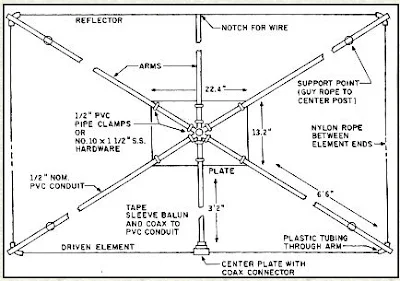I had thought that the Cebik files were lost to us in some sort of legal copyright struggle. But in my effort to better understand the Moxon antenna, I found a real treasure trove of Cebik's writing. These should all be saved somewhere safe.
I especially liked his description of the evolution of the Moxon antenna. Les Moxon was apparently very unAmerican in his emphasis on reception (not transmit gain) as the main benefit of the beam antenna. He also sought to avoid superfluous luxuries like rotators, but Cebik hints that rotators have become an important part of our American way of life. Indeed.
Before I found these files I had been on the verge of giving up on efforts to replace my storm-damaged Moxon. After all, solar minimum is still ahead of us. But after reading OM Cebik's articles I have decided to build a 20 meter version and place it above the center point of a 130 foot doublet. I will have the best of both worlds.
http://www.antentop.org/w4rnl.001/mu0.html
http://www.antentop.org/w4rnl.001/mu2a.html
L. A. Moxon, in his HF Antennas for All Locations, provides the essential clue: "the main benefit [of a beam] accrues from the reduction of interference during reception, though the 4 to 6 dB gain provided by typical amateur beams is an important bonus and probably the reason which carries the most weight with the majority of amateurs."(2)Here is a theory of beam operation quite unAmerican is style: instead of gain, Moxon strives for front-to-back ratio as the most crucial aid to ham operation. His statement is an affirmation of the "good ears" theory of operation. Even more, it forms the basis for his rectangular improvement upon the VK2ABQ square.
...
Moxon prefers matched elements, tuning each of them to optimum performance remotely. That way, he can reverse the beam and do away with expensive and maintenance-intensive rotators. However, rotators are a way of life in the U.S. (a TV rotator will likely handle a 3-band Moxon beam), and there are many uses for portable beams that are hand-rotated or fixed in the field. Thus, I decided to continue the exercise in unequal element lengths.
http://www.antentop.org/w4rnl.001/mox20.html
Finally, a treasure trove of Cebik's writing:
http://www.antentop.org/w4rnl.001/radio.html


Hi Bill, a 20M Moxon might be a little unwieldy for one person. Drop me a line if you need a second hand.
ReplyDelete